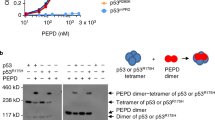Abstract
The N-terminal proline-rich domain of human p53 has been shown to be important for the induction of apoptosis. However, the corresponding region in mouse and other species is not highly conserved and has been less well studied. In this paper, we have characterized mutants with deletions in this region of mouse p53. Our results demonstrate that deletions in the proline-rich domain have varying effects on function ranging from no effect to severe impairment of cell death activity, depending on precisely which residues are deleted. We also show that the mutants differ in their ability to transactivate different p53 target promoters. Although we have been able to obtain mutants selectively impaired for apoptosis, our data are not generally consistent with this region being a functional domain. The data are more consistent with the interpretation that the region influences function by altering local protein structure which may affect promoter discrimination.
This is a preview of subscription content, access via your institution
Access options
Subscribe to this journal
Receive 50 print issues and online access
$259.00 per year
only $5.18 per issue
Buy this article
- Purchase on Springer Link
- Instant access to full article PDF
Prices may be subject to local taxes which are calculated during checkout




Similar content being viewed by others
References
Baptiste N, Friedlander P, Chen X and Prives C . (2002). Oncogene, 21, 9–21.
Bensaad K, Rouillard D and Soussi T . (2001). Oncogene, 20, 3766–3775.
Brodsky MH, Nordstrom W, Tsang G, Kwan E, Rubin GM and Abrams JM . (2000). Cell, 101, 103–113.
Chen X, Ko LJ, Jayaraman L and Prives C . (1996). Genes Dev., 10, 2438–2451.
Derry WB, Putzke AP and Rothman JH . (2001). Science, 294, 591–595.
Ginsberg D, Mechta F, Yaniv M and Oren M . (1991). Proc. Natl. Acad. Sci. USA, 88, 9979–9983.
Hansen RS and Braithwaite AW . (1996). Oncogene, 13, 995–1007.
Haupt Y, Rowan S, Shaulian E, Vousden K and Oren M . (1995). Genes Dev., 9, 2170–2183.
Imai Y, Matsushima Y, Sugimura T and Terada M . (1991). Nucleic Acids Res. 19, 2785.
Jackson P, Bos E and Braithwaite AW . (1993). Oncogene, 8, 589–597.
Jin S, Martinek S, Joo WS, Wortman JR, Mirkovic N, Sali A, Yandell MD, Pavletich NP, Young MW and Levine AJ . (2000). Proc. Natl. Acad. Sci. USA, 97, 7301–7306.
Masuda H, Miller C, Koeffler HP, Battifora H and Cline MJ . (1987). Proc. Natl. Acad. Sci. USA, 84, 7716–7719.
Ollmann M, Young LM, Di Como CJ, Karim F, Belvin M, Robertson S, Whittaker K, Demsky M, Fisher WW, Buchman A, Duyk G, Friedman L, Prives C and Kopczynski C . (2000). Cell, 101, 91–101.
Perrem K, Rayner J, Voss T, Sturzbecher H, Jackson P and Braithwaite A . (1995). Oncogene, 11, 1299–1307.
Prives C and Hall PA . (1999). J. Pathol., 187, 112–126.
Rogan EM, Bryan TM, Hukku B, Maclean K, Chang AC, Moy EL, Englezou A, Warneford SG, Dalla-Pozza L and Reddel RR . (1995). Mol. Cell. Biol., 15, 4745–4753.
Ruaro E, Collavin L, Del Sal G, Haffner R, Oren M, Levine A and Schnieder C . (1997). Proc. Natl. Acad. Sci. USA, 94, 4675–4680.
Sakamura D, Sabbatini P, White E and Prendergast G . (1997). Oncogene, 15, 887–898.
Schumacher B, Hofmann K, Boulton S and Gartner A . (2001). Curr. Biol., 11, 1722–1727.
Soussi T, Caron de Fromentel C and May P . (1990). Oncogene, 5, 945–952.
Walker KK and Levine AJ . (1996). Proc. Natl. Acad. Sci. USA, 93, 15335–15340.
Yonish-Rouach E, Resnitzky D, Lotem J, Sachs L, Kimchi A and Oren M . (1991). Nature, 352, 345–347.
Yu H, Chen JK, Feng S, Dalgarno DC, Brauer AW and Schreiber SL . (1994). Cell, 76, 933–945.
Zhu J, Jiang J, Zhou W, Zhu K and Chen X . (1999). Oncogene, 18, 2149–2155.
Acknowledgements
We thank Moshe Oren (Rehovot), Xin Lu (London) for reporter constructs, Roger Reddel (Sydney) for IIICF/c cells and Janice Royds for comments on the manuscript. The work was supported by the Health Research Council, the Cancer Society, the Royal Society and Lottery Health.
Author information
Authors and Affiliations
Corresponding author
Rights and permissions
About this article
Cite this article
Edwards, S., Hananeia, L., Eccles, M. et al. The proline-rich region of mouse p53 influences transactivation and apoptosis but is largely dispensable for these functions. Oncogene 22, 4517–4523 (2003). https://doi.org/10.1038/sj.onc.1206726
Received:
Revised:
Accepted:
Published:
Issue Date:
DOI: https://doi.org/10.1038/sj.onc.1206726
Keywords
This article is cited by
-
TP53 mutations as potential prognostic markers for specific cancers: analysis of data from The Cancer Genome Atlas and the International Agency for Research on Cancer TP53 Database
Journal of Cancer Research and Clinical Oncology (2019)
-
The proline rich domain of p53 is dispensable for MGMT-dependent DNA repair and cell survival following alkylation damage
Cell Death & Differentiation (2017)
-
Activation of p53 following ionizing radiation, but not other stressors, is dependent on the proline-rich domain (PRD)
Oncogene (2013)
-
p53-mediated apoptosis prevents the accumulation of progenitor B cells and B-cell tumors
Cell Death & Differentiation (2010)
-
The proline-rich domain in p63 is necessary for the transcriptional and apoptosis-inducing activities of TAp63
Oncogene (2008)



